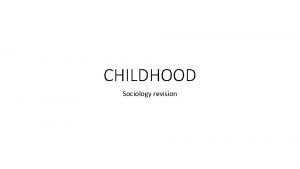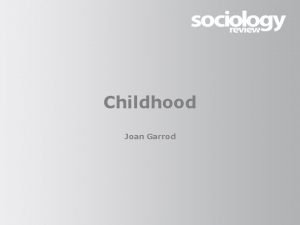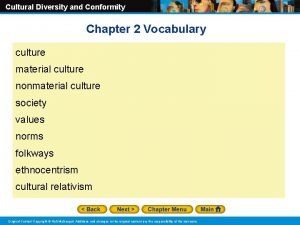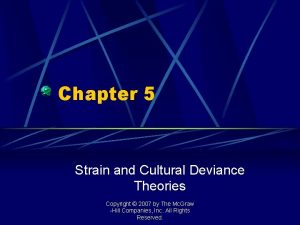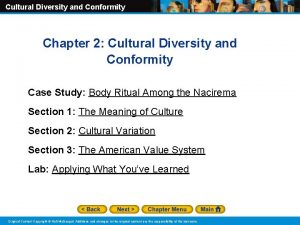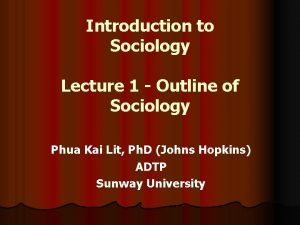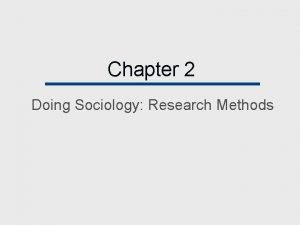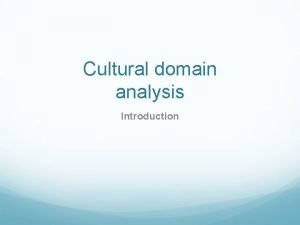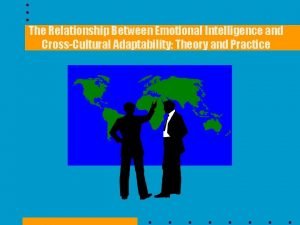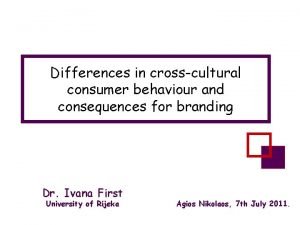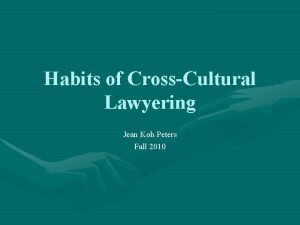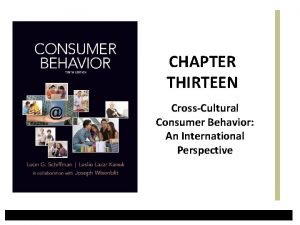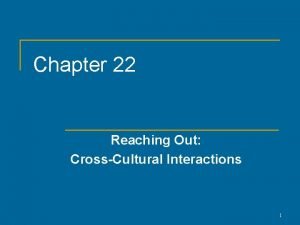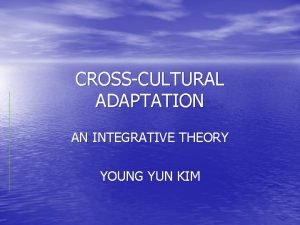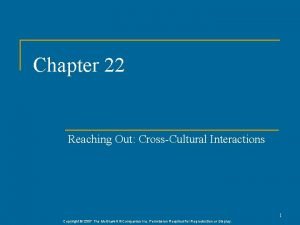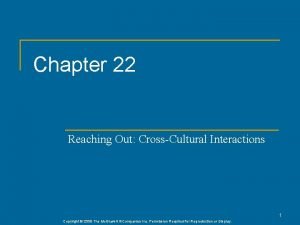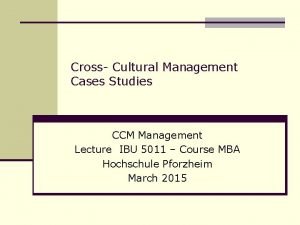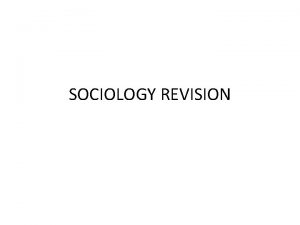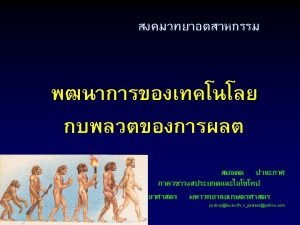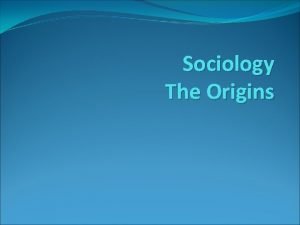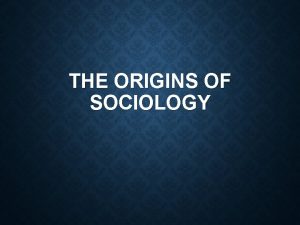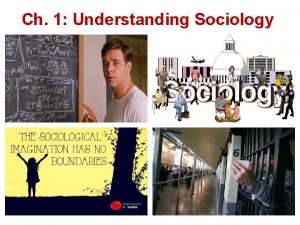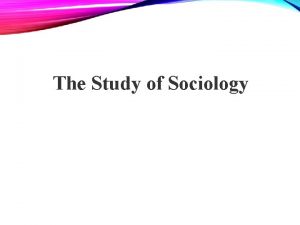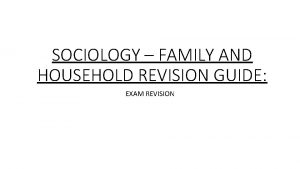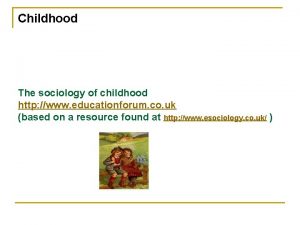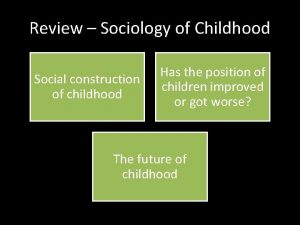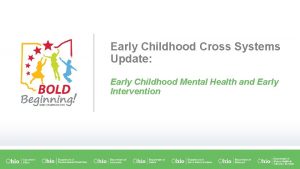CHILDHOOD Sociology revision OUTLINE OF CHILDHOOD Cross cultural

































- Slides: 33

CHILDHOOD Sociology revision

OUTLINE OF CHILDHOOD… • Cross cultural differences: Childhood as a social construction, Townsend 2003 Children who are not protected Punch Holmes Bonke Hillman Howard Firestone (child liberation) Gittens (age patriarchy) Hockey and James • History of childhood: • The future of Childhood: Three time periods Aries Reasons for changes March of Progress view Conflict view Postman (death of childhood) Globalisation of western childhood, Palmer (toxic childhood) Opie

Cross Cultural Differences.

Social construction: • Childhood is difficult to explain as it is a ‘social construct. ’ • This means that it is created by society, or its institutions rather than being a natural occurrence. As it is defined by society, it therefore varies over time – and between cultures/location.

UK childhood: • In the UK, childhood is now seen as a period of ‘separateness’ – this is an idea put forward by Jane Pilcher. This means that children are now distinctly different to adults. Ways in which we make sure the two are separate include having specific laws to protect children from the world of work, separating children into education, and offering safe guards, such as the 1989 ‘children's act. ’ which prohibited children from adult activities through age of consent. • In the UK childhood is also seen as the ‘golden age’ of happiness and innocence. Therefore children are seen as being in need of protection.

EVIDENCE: • By looking at different cultures, and how children are treated and expected to live – helps to argue that childhood is a construction and that it varies from society to society.

EVIDENCE: • For example, in the developing world, many children are living in poverty and are at high risk of illness and death. Therefore suggesting I is not a ‘golden age’ for all children. • One study that provided evidence for this was Townsend (2003) which found; - 1/3 of children between 7 -18 had never been to school, - 1/3 of children are living in absolute poverty, - Over 375 million children use unsafe water sources.

Disease: • It has generally been found that children living in the developing world are at far greater risk of catching disease, and in some countries 1/5 of children die before their 5 th birthday.

Protection: • Evidence that children in other countries are not often protected could be shown through the 2010 statistics given by African nations, which showed that 1/5 th of children between the ages of 5 -14 were now working. • Although children may want to be protected, there is just not enough recourses available, and many children actually have to fend for themselves from a very young age due to death of parents, abandonment or illness.

Child soldiers: • Along with that evidence, there is more to show that the world of adults and children are a lot less separate in other countries – as children enter into work, parenthood and even war (at very young ages) for example, child soldiers. • Worldwide over half a million children under the age of 18 are child soldiers, taught to kill others (even family) for example, Joseph Kony’s ‘lords resistance’ army in Uganda.

EVIDENCE: • Some research into cross cultural differences includes; • PUNCH’s research into rural Bolivia. He found that children were made to work at the age of 5. • And HOLME’S research in a samoan village. Who found that ‘too young’ was never an excuse for a child to take on adult tasks.

General differences between childhood in the UK and the Developing world: UK DEVELOPING WORLD • Laws prevent children from working and ensure that they are educated, • Children are separated from violence and sex, • A lot of resources are spent on health/education • Laws protect children from the adult world. (1989 children’s act) • There aren’t enough resources available, therefore children are at high risk of disease and illness. • Children are put into work, war, and parenthood. • There’s a lot of poverty and lack of schools therefore = causes child labour. • Are taught to fend for themselves.

The History of Childhood.

Time periods: • As childhood is seen to be a social construct, it also means that it varies over time. • The history of childhood in the UK is generally divided into three different stages; - Pre industrial society, which is anything up until 1760. - Industrial society, which is 1760 – onwards. - And the modern society which was 1960 – and onwards.

ARIES: • Aries said that n the preindustrial time period, society was based on agriculture, in the industrial time period it was based on manufacture, and in the post modern stage – it was (and still is) based on technology. • Arie’s stated that in the preindustrial time period there was NO distinct childhood. As children worked, married and were treated the same as adults. • He then said that during the Victorian era, as we started to industrialise – there was less need for child labour as most of the work was done by machinery. Children were instead sent into education! • We now see childhood as a separate time from adulthood.

Evaluation of Aries: • People however did criticise Aries, as he used secondary sources, which may not have been valid or reliable, nevertheless. His work did show childhood was constructed differently in the past. Therefore supporting the idea of childhood being a social construct.

Reasons for changes: • The reasons put forward for the changes in childhood include; • child protection laws, • compulsory education, • the decline in infant mortality rates, • parents working fewer hours, • and age restrictions in the law.

March of Progress view: • There is now a march of progress view regarding childhood, that is mainly put forward by Peter and Brigette Berger. (the Berger’s) who clame that more and more attention is being spent on children and they are now the focus of family life. This means that the family is now becoming ‘child centred’ They say this is shown through; • how much it now costs to raise a child (£ 186, 000) • The time and attention given to children (family days out) • The fact there are now books and TV programmes designed to help parents.

Conflict view: • The conflict view see the march of progress view as an over idealised view of childhood. They instead argue that inequalities now exist within childhood. (between children, and between children and adults) • Marxists and feminists disagree that there is a march of progress occurring in childhood, but instead believe the family is used as a ‘tool of the powerful’ and to pass on patriarchal and capitalist ideologies. They also focus on the inequalities children face between each other but also between adults. For example…

EVIDENCE: • There has been research conducted into inequalities of gender such as: • BONKE = who found that girls do more domestic labour than boys. • HILLMAN = who found that boys generally had more freedom of movement e. g. to cross roads, to be out late than girls. • There has also been inequalities found between different classes: • HOWARD = found that children born into poor families were more likely to fall behind in school, suffer from illnesses and die in infancy/ childhood.

FIRESTONE: • Firestone argues that there has also been inequalities found between children and adults, which is bad. • She believes that adults exercise their power not to protect, but to oppress children. She therefore argues that children should be ‘freed’ from this = this is child liberationalism.

FIRESTONE: • Firestone said that adults have control over children’s; - Time (controls the time of when they can grow up. ) - Body (what they can eat, the amount of exercise etc. ) - Resources (made to be financially dependent on adults) - Space (in 1971, 80% of 7 -8 year olds were allowed to go to school without supervision. In 1990, this had only increased by 9%) • She also found that in 2006, 31, 400 children had been put on the child register because they were deemed at risk of harm.

GITTENS: • Gittens, used the term ‘age patriarchy, ’ to describe the inequalities between children and adults. She said that males oppress both women and children as they exploit their position of power. • Statistics found of domestic violence is able to back this point up.

HOCKEY AND JAMES: • Hockey and James found evidence that children do find childhood to be oppressive, and claim that children have developed two key strategies to deal with it. 1) Acting UP = this means acting older than they actually are, e. g. dressing up, wanting to go out. 2) Acting DOWN = this means acting younger than they are, e. g. clinging onto parents.

Evaluation: • People do criticise the child liberation view for many reasons, • One being, the fact that children do need adult care, control and attention. • Another being the fact children are not powerless, they can react against the adult control.

The Future of Childhood.

The future of childhood key ideas: 1) THE DEATH OF CHILDHOOD. (Postman) 2) TOXIC CHILDHOOD. (Palmer) 3) GLOBALISATION OF WESTERN CHILDHOOD.

POSTMAN: • Postman (postmodernist) claims that childhood is disappearing. This is because TV now provides endless information that children can now assess. • He believed that the age of separation was due to the fact adults could assess more information/knowledge than children as they could read. • He therefore argues that now, children lack innocence and that the separate era has ended.

Toxic Childhood: • Palmer, believed childhood was toxic. Meaning it is now damaging children physically, emotionally and intellectually. This is because children have too much access to information with not enough parental control. • In palmers research she broke it down into 10 areas, which included; lack of sleep & play, diet, and changes in education. • She believed that the movement of TV’s into children's bedrooms was the worst idea as children are able to channel hop and see things like the news (war) • She argues that if we continue being the way childhood is nowchildren may not be bright enough to carry on society.

OPIE: • Opie, argues that childhood actually isn’t really dying, or even changing that much as we still play a lot of the games that children used to – and sing the same songs/rhymes. Therefore he argues that childhood isn’t all that different to how it used to be decades ago.

Globalisation of Western childhood: • The globalisation of western childhood argues that due to the mass media, the western concept of childhood has been exported across the globe. The evidence of this is shown through the fact there are now charity campaigns and posters that echo the western values e. g. homeless children/ children on the streets (drugs) and marriage.

EVALUATION: • Many of todays theorist see childhood as under threat, or that it is disappearing. However it isn’t like this for everyone- and some people have it worse than others. • E. g. poorer children are more effected, and the end of separation is not true for all areas, due to things like compulsory education.

SUMMARY OF CHLDHOOD: • Childhood is a social construction meaning it varies over time and between countries/cultures. • In the uk it is seen as a time of innocence and separateness from parents, this is due to lawsinfant morality rates, and compulsory education. However in the developing world children are still made to work – go to war, and have no resources therefore at a high risk of illness/death. • Research into cross cultural differences = Townsend, punch, Holmes. & statistics from African nations. • Some think the future of childhood is disappearing (postmodernists) others think it is toxic. • Others see that there is a globalisation of western ideas about childhood. • Research into the future of childhood = palmer, postman, Opie. • Over time childhood has changed – preindustrial (1760) industrial (1760 +) modern (1960 +) • Aries said childhood wasn’t a thing until industrialisation occurred and children were put into education. • March of progress theorists (Berger's) believe we are now child centred due to the amount of time, money and attention we give children. However conflict theorists (feminists/Marxists) believe that the family just passes on patriarchal/capitalist ideology. • Research into the history of childhood = Aries, firestone, gittens, hockey and James, Howard, Hillman, bonke.
 Passive sentence
Passive sentence Crime and deviance sociology revision
Crime and deviance sociology revision March of progress view
March of progress view Aries sociology childhood
Aries sociology childhood Define cultural leveling
Define cultural leveling Cultural diversity and conformity section 1
Cultural diversity and conformity section 1 Cultural deviance theory
Cultural deviance theory Cultural diversity and conformity section 3
Cultural diversity and conformity section 3 Labeling theory
Labeling theory Sociology lecture
Sociology lecture Advantage and disadvantage of observation method
Advantage and disadvantage of observation method Middle childhood and adolescence
Middle childhood and adolescence Cultural domain meaning
Cultural domain meaning Quotation sandwich
Quotation sandwich Cross cultural adaptability inventory
Cross cultural adaptability inventory Cross cultural consumer behaviour
Cross cultural consumer behaviour Cross cultural differences and similarities
Cross cultural differences and similarities Jean koh peters
Jean koh peters Cross cultural communication
Cross cultural communication Cross cultural consumer analysis
Cross cultural consumer analysis Cross cultural communication and negotiation
Cross cultural communication and negotiation Cross cultural negotiation and decision making
Cross cultural negotiation and decision making Chapter 22 reaching out cross-cultural interactions
Chapter 22 reaching out cross-cultural interactions Young yun kim
Young yun kim Cross cultural communication and negotiation
Cross cultural communication and negotiation Chapter 22 reaching out cross-cultural interactions
Chapter 22 reaching out cross-cultural interactions Chapter 22 reaching out cross-cultural interactions
Chapter 22 reaching out cross-cultural interactions Importance of cross cultural leadership
Importance of cross cultural leadership Cross-cultural preparation
Cross-cultural preparation Terry cross cultural competence
Terry cross cultural competence Examples of cross cultural communication
Examples of cross cultural communication Short case study on cross cultural management
Short case study on cross cultural management Test cross and back cross
Test cross and back cross Test cross and back cross with example
Test cross and back cross with example


